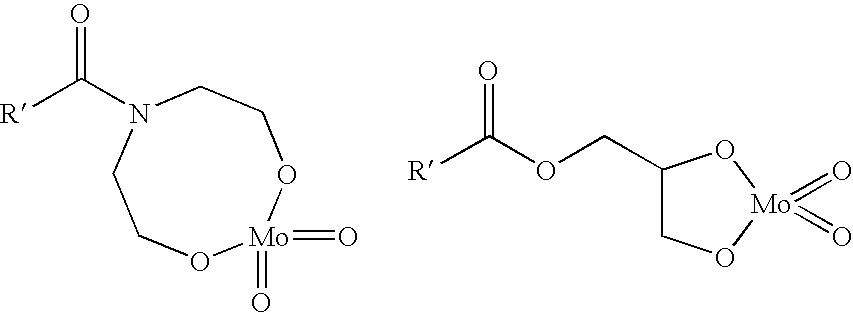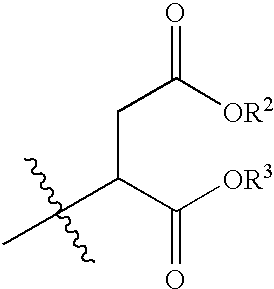Antioxidant additive compositions and lubricating compositions containing the same
- Summary
- Abstract
- Description
- Claims
- Application Information
AI Technical Summary
Benefits of technology
Problems solved by technology
Method used
Image
Examples
embodiment embodiment embodiment
Components 1 (%) 2 (%) 3 (%) Total of composition 0.15-12.0 0.40-8.5 0.75-3.5 (1) + (2) + (3) (1) Organomolybdenum 0.05-3.0 0.10-2.0 0.15-1.0 compound (2) ADPA 0.05-5.0 0.1-2.0 0.20-1.5 (3) Sulfur-containing 0.05-4.0 0.20-2.5 0.40-1.0 compound* (a) Thiadiazole 0-4.0 0-2.5 0-1.0 (b) Dithiocarbamate 0-4.0 0-2.5 0-1.0 *thiadiazole dithiocarbamate, or mixtures thereof
This invention is useful with phosphorous dithiophosphate compounds. Embodiments of dithiophosphates for the present invention include:
(1) Metal Phosphorodithioates ##STR7##
The metal phosphorodithioates of the formula V are known, commercially available materials. One of the processes of preparation is taught by U.S. Pat. No. 4,215,067, which is hereby incorporated by reference. (M and n are as defined above for the metal dithiocarbamates) R.sup.15 and R.sup.16 represent branched and straight chain alkyl groups having 1-22 groups and may be derived from fatty acids and embodiment of which are the zinc phosphorodithioates. T...
examples
In Tables 1 and 2, the present invention is compared with a composition taught by U.S. Pat. No. 5,840,672 (Comparative Examples 1 and 4). Tables 1 and 2 each compare an inventive composition with a different sulfur compound to the prior art compounds. Examples 2 and 5 are inventive compositions in which the equivalent weight percent of the corresponding three components of comparative examples 1 and 4, are maintained. That is, the compositions (comparing Example 2 to 1; and Example 5 to 4) are identical except for the sulfur component, either sulfurized isobutylene or thiadiazole. Examples 3 and 6 are identical to comparative examples 1 and 4, respectively, except that the sulfur compounds differ as shown. However, in these cases, while the sulfur compounds and the amounts of the compounds in each composition differ, the amount of sulfur in each example is the same. Thus, this second group illustrates the effect of the difference in sulfur compound used, independent of the amount of...
examples 2 and 3
show a reduction in deposits and improved anti-oxidative properties relative to comparative example 1. Examples 5 and 6 show a reduction friction coefficient relative to comparative example 4.
Table 2--Test of Additive Composition in Lubricating Composition
(Organomolybdenum Compound, Alkylated Diphenylamine and Dithiocarbamate)
The table below compares examples of the additive compositions of the invention (examples 8, 10 and 11) with examples from U.S. Pat. No. 5,840,672 (comparative examples 7 and 9) which utilizes a sulfurized isobutylene in lieu of a sulfur compound.
All tests were generally conducted in accordance with the ASTM test methods designated in parenthesis below.
7 8 9 10 11 Organomolybdenum (Molyvan .RTM. 855) 0.16 0.16 0.40 0.40 0.40 Alkylated diphenylamine (Vanlube .RTM. 81) 0.20 0.20 0.20 0.20 0.20 Sulfurized Isobutylene (Vanlube .RTM. SB) 0.40 -- 0.40 -- -- Methylene bis(dibutyl) dithiocarbamate -- 0.40 -- 0.40 0.93 (Vanlube .RTM. 7723) Dispersant TC 9596A 91-4284 5....
PUM
 Login to View More
Login to View More Abstract
Description
Claims
Application Information
 Login to View More
Login to View More - R&D
- Intellectual Property
- Life Sciences
- Materials
- Tech Scout
- Unparalleled Data Quality
- Higher Quality Content
- 60% Fewer Hallucinations
Browse by: Latest US Patents, China's latest patents, Technical Efficacy Thesaurus, Application Domain, Technology Topic, Popular Technical Reports.
© 2025 PatSnap. All rights reserved.Legal|Privacy policy|Modern Slavery Act Transparency Statement|Sitemap|About US| Contact US: help@patsnap.com



